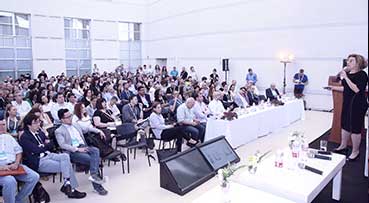Amid wars and pandemics, discussions around working in uncertain conditions have grown commonplace, focusing on both personal and organizational resilience. Although managerial roles in fostering resilience are undeniably vital, it’s essential to differentiate between resilience emerging from organizational culture, strategic capabilities, market dynamics, and economic landscapes and the resilience required during a crisis. So what does resilience truly entail in emergencies, and how can managers fortify it? During a crisis managers can cultivate two crucial forms of resilience: business and human.
Ensuring Business Resilience through Adaptability
Business continuity isn’t merely a goal; it’s a necessity. As the famous line from “The Godfather” puts it: “It’s not personal, it’s business.” When a crisis is local, despite empathetic sentiments from customers, suppliers, and international stakeholders, the bottom line remains that we operate in a commercial landscape. Implicit questions loom about the impact of the crises on customer service, project timelines, and contractual obligations. Therefore, the essence of business resilience lies in safeguarding your core functions while strategically deprioritizing non-essential tasks.
The initial step is to hold a candid conversation about priorities, risk evaluations, and clearly marking what’s critical and urgent. Encourage managers across departments to identify vulnerabilities affecting business continuity. From there, outline and prioritize essential tasks, ensuring staff understand the rationale behind resource allocation, even if it results in a dramatic operational pivot. This is pivotal because most contemporary organizations lack the agility to reallocate resources promptly.
Tackling emergent needs necessitates not just flexibility, but also networked management, delegated authority, and sometimes even cross-training. Consider the supermarket scenario—produce employees chat while cash registers are understaffed. Why not cross-train workers to switch roles during peak hours? Cross-training fosters flexibility, allowing for quick adaptation to the most pressing tasks. Simultaneously, it offers employees developmental opportunities and a sense of purpose—key ingredients for personal resilience. Witness the number of people transcending their everyday roles to engage in larger humanitarian efforts, motivated by a heightened sense of mission amidst the ongoing conflict in Israel. Organizations should embrace this ethos for maintaining business continuity, accentuating its importance to all involved.
The Imperative of Transparent Communication for Crisis-Resilient Organizations
Transparent, continuous, and clear communication is not just a managerial best practice; it’s the bedrock of resilience, particularly in times of crisis. It’s crucial that everyone comprehends not only what the priorities are, but also what they’re not—equipping staff with the knowledge they need to navigate their roles and responsibilities effectively. Moreover, enabling individuals to take ownership within the evolving landscape of organizational constraints empowers them to adapt and meet challenges head-on.
Global organizations have been particularly vocal in communicating the criticality of business continuity, often linking it to investor confidence in larger geopolitical landscapes. By openly articulating the direct nexus between foreign investment decisions and an organization’s ability to meet key obligations during crises, managers galvanize staff to focus on what’s truly essential. This not only advances company goals but also sustains investor commitment, making the larger economic ecosystem more resilient.
Frequent, open dialogue is non-negotiable. Attentive managers who keep channels of communication open will gain insights into organizational bottlenecks, misaligned decisions, skewed priorities, and unforeseen challenges. Because in a fluid environment—especially during crises—every plan is merely a starting point for adaptations. Ongoing conversations not only reveal what is or isn’t working but also illuminate the specific needs of the workforce, who are, after all, the lifeblood of any resilient organization.
Nurturing Human Resilience: When Life Takes Precedence Over Work
When it comes to the push and pull between work and life, life invariably triumphs. This is particularly critical to remember during crises, where stripping away barriers that hinder work-life balance becomes paramount. Creating a space where individuals feel safe to express their emotions, concerns, and coping mechanisms is essential. This goes beyond just the logistical hurdles of remote work or caregiving responsibilities—it addresses the emotional toll that distracts focus, fuels media consumption, and even inspires volunteerism. This is especially critical for those who are directly impacted by unfolding events.
Open dialogue, active listening, and empathy are managerial tools that shine brighter than ever in times like these, revealing what your people can realistically accomplish. But the conversation is a two-way street; you also need to disclose what you can and cannot do for your team. Flexibility, task prioritization, and empathetic conversations are your tools for addressing individual needs. Share authentically as a manager, thereby encouraging others to open up about their own challenges. Intra-organizational social networks have always fostered camaraderie but can serve as a literal lifeline in crises.
Understanding that people’s needs vary is crucial. For some, the reassurance lies in maintaining routine and stability amidst chaos. Others may require flexibility in location, timing, or workload to juggle life’s demands. And yes, there will be those who express their inability to focus or function—listen to them, too. This is a time to revisit and practice the work flexibility needed to prioritize life.
The crisis will eventually end and there will be a “day after”. Remember, actions and decisions made today cast long shadows on future business continuity, organizational culture, and employee engagement. As you navigate these testing times, taking care of your people means also taking care of yourself.
United, we will overcome.

![large-AX1A2125-2[1]](https://niritcohen.com/wp-content/uploads/elementor/thumbs/large-AX1A2125-21-pnzedcs72atx5aeurqytqdiihxixlq02re9mlz805s.jpg)






